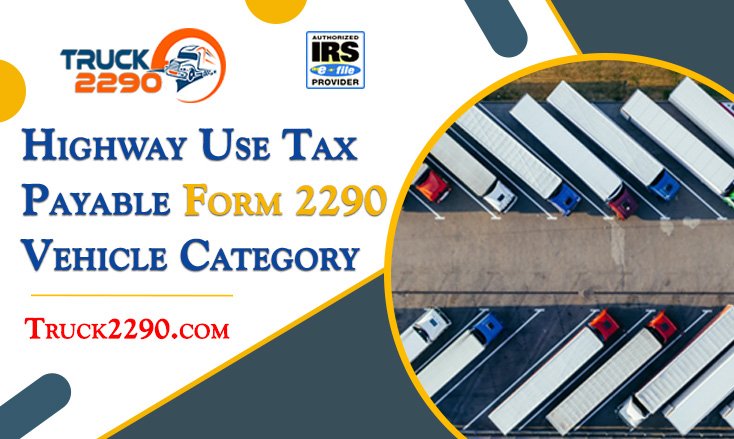Introduction:
When it comes to filing taxes for heavy vehicles, truck owners must navigate through the intricacies of IRS Form 2290, which is designed to report various types of vehicles. One crucial aspect of this form is understanding the 2290 Vehicle Category, as it plays a significant role in determining the tax liabilities associated with different types of vehicles. In this article, we will delve into the details of the 2290 Vehicle Category, exploring the distinctions between taxable and suspended vehicles, and shedding light on the specific requirements for privately purchased vehicles.

Types of Vehicles in the 2290 Vehicle Category:
As outlined by the IRS, the 2290 Vehicle Category is divided into two main types – Taxable Vehicles and Suspended Vehicles.
Taxable Vehicles:
- Commercial Vehicles: Commercial vehicles, referring to heavy motor vehicles used on highways for business purposes, fall under the taxable vehicle category. The tax imposed on commercial vehicles varies based on their gross weight and the tax period. For instance, if a commercial vehicle’s gross weight exceeds 75,000 pounds, the Heavy Vehicle Use Tax (HVUT) rate stands at $550 per annum. Truckers need to file 2290 truck taxes on time to avoid penalties and interest.
- Agricultural Vehicles: Vehicles primarily used for farming purposes are categorized as agricultural vehicles. These vehicles have a mileage use limit of 7,500 miles. If an agricultural vehicle exceeds this limit, the filer must submit a 2290 truck tax return. If the agricultural vehicle falls under the suspension category, no HVUT payment is required. However, the filer must still file Form 2290 to report the suspended vehicle status.
- Logging Vehicles: Logging vehicles, utilized for timber transport within forests, enjoy a 25% lower HVUT compared to commercial vehicles. This reduced tax rate acknowledges the specific use of these heavy vehicles for logging operations. Unlike commercial vehicles, logging vehicles do not have separate tags and plates for identification.
Suspended Vehicles:
a. Overview: Suspended vehicles are those heavy vehicles that do not exceed the minimum mileage limits set by the IRS. For commercial vehicles, the mileage limit is 5,000 miles, while agricultural vehicles have a limit of 7,500 miles. If these limits are not surpassed, the vehicle falls under the suspension category.
b. Reporting: Filing for tax-suspended vehicles does not require the payment of truck taxes under 2290. However, it is crucial to complete and submit Form 2290 to the IRS. The filing includes reporting the suspended vehicles under category W and providing the IRS with essential information about the status of the filer’s suspended vehicle.
c. Exceeding Mileage Limits: If tax-suspended vehicles surpass the mileage limits, the filer is obligated to pay the 2290 road tax to the IRS. In such cases, an amendment form for reporting suspended vehicles exceeding the mileage limit (Form 2290) must be filed promptly.
Privately Purchased Vehicles:
a. Definition: Privately purchased vehicles refer to those acquired or purchased for private use.
b. Filing Requirements: The IRS mandates Form 2290 HVUT filing for privately purchased vehicles if the gross weight exceeds 55,000 pounds or if the mileage limit exceeds 5,000/7,500 miles. Therefore, individuals who purchase used vehicles must file Form 2290 and pay highway taxes based on the vehicle’s gross weight and mileage limit, starting from the month of purchase.
Conclusion:
Understanding the nuances of the 2290 Vehicle Category is crucial for truck owners and business operators to ensure compliance with IRS regulations. Whether dealing with taxable vehicles, suspended vehicles, or privately purchased vehicles, accurate filing and timely payments are essential to avoid penalties and maintain smooth operations. For a hassle-free experience, consider utilizing e-filing solutions like Truck2290, providing a step-by-step guide to simplify the Form 2290 filing process and expedite the receipt of IRS watermarked 2290 Schedule 1 Proof. Start filing your new HVUT return with confidence and secure instant proof of payment with Truck2290.
Tags
2290 HVUT 2290 Online Filling 2290 Schedule 1 Proof 2290 tax 2290 Tax Form Online 2290 Truck Tax 2290 Vehicle Category E-file Form 2290 E-filing 2290 EIN Error Code Exemptions of Form 2290 File Form 2290 File Form 2290 Online Filling Requirements Form 2290 Form 2290 Deadline Form 2290 Due Date Form 2290 exemptions Form 2290 Penalties Form 8849 Gross Taxable Weight Heavy Vehicle Use Tax Heavy Vehicle Use Tax or HVUT HVUT HVUT Payment HVUT Penalty HVUT tax IRS 2290 phone number IRS approved e-file provider IRS Form 2290 Due Date IRS From 2290 IRS HVUT Tax IRS regulations IRS Schedule 1 IRS Schedule 1 Proof IRS Tax Form IRS Tax Relief Pay HVUT Stamped Schedule 1 Tax Form 2290 Tips For Truckers Truck2290 Truck Driver VIN correction
